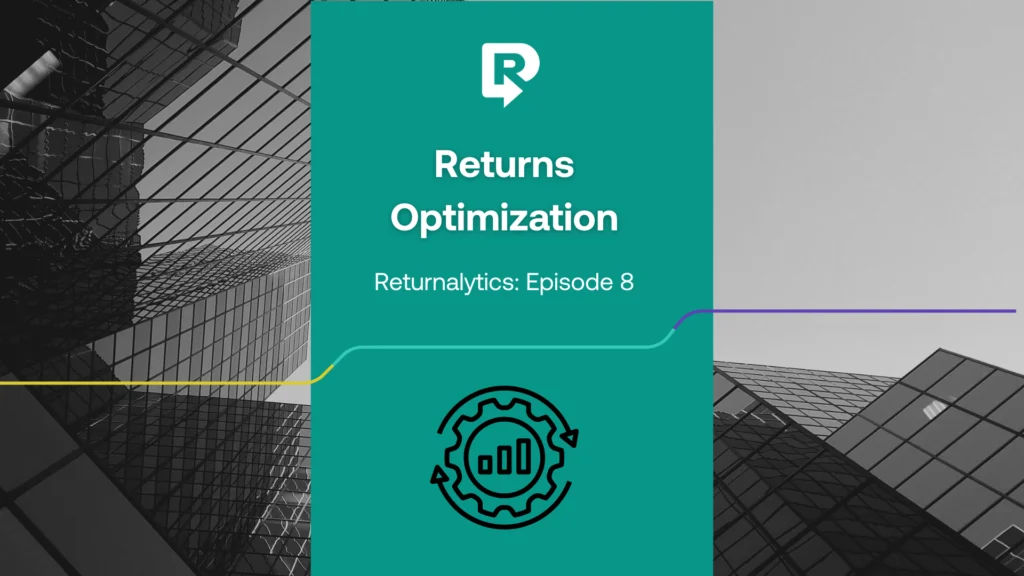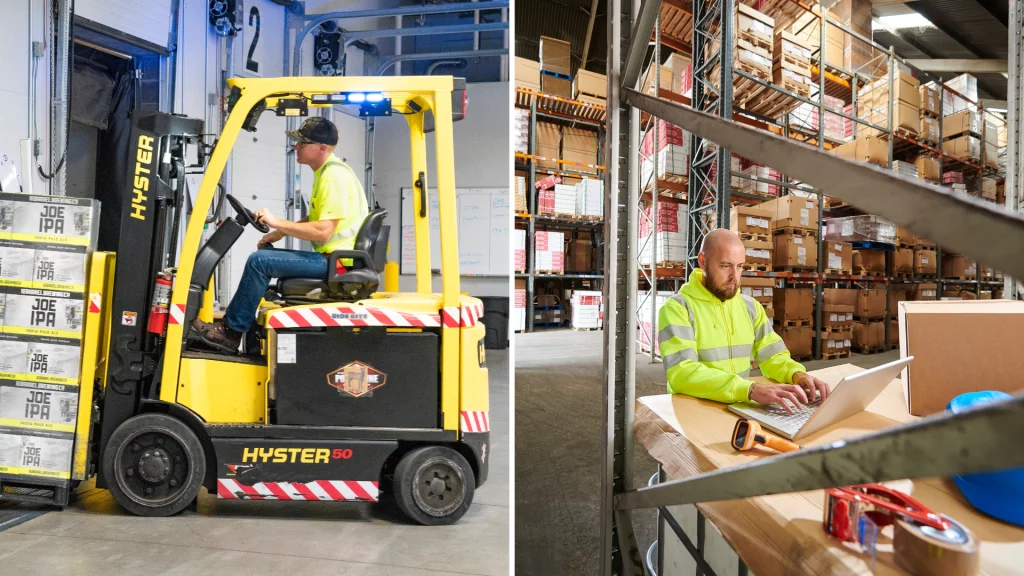Returnalytics: What is Returns Optimization and How Can You Optimize Your Returns Process?

About the Episode
The Returnalytics podcast discusses the latest retail trends, technology, and best practices for managing an ecommerce business and retail returns.
In this episode, we’re discussing a term that is catching a lot of buzz:
Returns Optimization
Returns Optimization is defined as ‘continuous improvement strategies that use returns data to improve the shopper experience, improve operational efficiency, and grow profits’.
Put another way, returns optimization focuses on improving the returns process for retailers, reducing return rates from shoppers, streamlining operations and increasing customers’ lifetime value. Returns optimization is fueled by returns data.
Returns data unlocks powerful insight for retailers that allows them to see where things are going wrong in their returns process so that they can make the right adjustments to fix them.
Without returns data, merchants can’t see the full picture of their reverse supply chain and won’t have the depth of information on their products or shoppers to keep growing.
Listen in to learn how you can use Returns Optimization to fuel your business and take your shopping experience to the next level.
About the Speakers
Travis Farey
Travis is a Product Marketing Specialist at ReturnLogic. Travis graduated from Shippensburg University with a Bachelor of Science in Supply Chain Management & Marketing. Travis has been working for ReturnLogic for over 2 years and started out as a Customer Support Specialist before working his way into Product Marketing.
David Gonzalez
David is a Senior Growth Manager at ReturnLogic, previously working as a Product Marketing Manager. David has prior startup experience formerly working at Drip and WhenIWork. He works closely with the Product, Sales, and Marketing teams at ReturnLogic to act as the voice of the customer and how to understand the ecommerce market.
Episode Transcription
Travis Farey – 0:00
Hi, I’m Travis Farey and this is the returns management podcast by ReturnLogic; a show where we connect ecommerce store owners together through casual discussion and examine current myths and trends to keep you up to date on everything happening in the ecommerce world.
Returns Optimization. A new term or so some think. But we’ve been talking about Returns Optimization since 2015. On today’s episode we’re going to show you what all the hype is about and how you can optimize your returns process.
My name is Travis Farey and I am a Product Marketing Specialist here at ReturnLogic
And today I am joined by David Gonzalez Senior Growth Marketer here at ReturnLogic
So, let’s get this show rolling.
David Gonzalez – 1:03
You know, Travis, I feel like I’ve just heard this Returns Optimization term somewhere else. I must be having some déjà vu.
Travis Farey – 1:10
Well, don’t worry, David, you’re not going crazy, well, at least not in this specific instance because we just did a whole episode on the returns hierarchy of needs.
David Gonzalez – 1:21
Ahh that’s right. The whole automation, visibility, and optimization thing. That’s definitely where I’ve heard it before. Or maybe it’s top of mind because it’s the new headline, for one of our competitor’s websites, but that’s neither here nor there.
Travis Farey – 1:36
Sheesh. Keep the gloves on there, David. Let’s focus on our listeners.
David Gonzalez – 1:40
Alright. Alright. So, Travis for those who haven’t listened to the latest episode, last episode, excuse me, let’s jump into what Returns Optimization actually means.
Travis Farey – 1:51
That’s a great plan. So, Returns Optimization is continuous improvement strategies that use returns data to improve the shopper experience, improve operational efficiency, and grow profits.
David Gonzalez – 2:04
Right. So that’s probably the definition they have in Marriam-webster’s dictionary, I imagine. But if we boil it down, Returns Optimization focuses on improving the returns process, reducing return rates, streamlining operations, and increasing a customers’ lifetime value.
Travis Farey – 2:21
Okay. David, trying to steal my thunder. I see you, well an even easier way of explaining it is that returns data fuels returns optimization.
David Gonzalez – 2:31
I’ll do you one better. Returns Optimization helps retailers mitigate the number of returns they have to deal with overall.
Travis Farey – 2:40
Wow. One upper.
David Gonzalez – 2:42
Well let’s, let’s be clear, I’m not suggesting that retailers will have less returns as they grow. What I’m saying is with returns optimization, retailers won’t have to deal with as many sales becoming returns in the first place. As an analogy instead of throwing a band-aid on the problem you’re cauterizing the wound.
Travis Farey – 3:02
Wow. Looks like that pre-med degree didn’t go to waste their David.
David Gonzalez – 3:06
Yeah, tell that to my dad.
Travis Farey – 3:07
Well David’s father, if you’re listening in just know it all worked out in the end. But anyways, let’s dive into the benefits of returns optimization.
David Gonzalez – 3:17
Let’s do it.
Travis Farey – 3:19
Great. Well, David, I think before we can actually get into the benefits, we need to look at why shoppers are returning products. So, I read an article the other day by Shopify where they broke down some percentages of why shoppers were returning their items. So, 30 percent said the item was too small, 22 percent said the item was too large, not as described was at 5 percent and so on. So, are you noticing any trends here David?
David Gonzalez – 3:48
Yeah. From the looks of it, most if not all of those reasons sound like they can be prevented or put it another way there within the retailer’s control.

Travis Farey – 3:57
Exactly, returns data unlocks powerful information such as these percentages which allow retailers to see where things are going wrong in their processes so they can make the right adjustments to fix them. And without returns data merchants won’t see the full picture and won’t have the depth of info on their products and shoppers to keep growing.
David Gonzalez – 4:20
Interesting. That’s a good strategy. But why is optimization so important versus let’s say, you know, just incentivizing shoppers who return an item to make an exchange?
Travis Farey – 4:30
Yeah, that’s a great question. Incentivizing shoppers to choose an exchange over a refund or store credit can help a lot of brands scale to new heights. But with the growing number of exchanges, new problems continue to pop up. Exchanges don’t make sense for every product. T-shirts yup, works great. Broken sunglasses. Not so much. Shoppers can also game the system. They learn, they can get discounts. Every time they buy something, they can get a 10 percent discount if they return it. Then if they do that, they may get blacklisted and Bam all the money you spent to acquire that customer gets wasted and you’ve now lost a customer.
David Gonzalez – 5:10
That’s such a good point. One of the questions that retailers can ask themselves is who are my most profitable customers? And normally their most profitable customers are people who return the most stuff ironically. But there are two other points that I’ll add here. Making exchanges easier for shoppers doesn’t always correlate with meaning that a merchant can process them any quicker, doesn’t mean they can liquidate it faster, resell it any better. So overall without that operational efficiency, there can be problems. Also, exchanges don’t cover items covered by warranties, which begs the question if we’re all so focused on making exchanges as easy as possible for our teams and for shoppers, why should warranties be treated any different? But that’s a handful of things, let’s boil that down to one simple sentence here. Exchanges are a tool you can use, not a long-term strategy.
Travis Farey – 6:09
Right. And that’s not to say that exchanges aren’t great for things like revenue, retention, and growth because they are, but they’re only a piece of a much larger puzzle. As an eCommerce brand, the real strategy for growth is knowing where your scalability choke points are and then acting accordingly.
David Gonzalez – 6:28
Absolutely. So, why does all this matter? What data matters? What should merchants be measuring; how do they actually optimize returns? It is just as easy as just, you know, checking their return rates all the time or what do they do?
Travis Farey – 6:40
Unfortunately, no, just checking your return rates is not enough.
David Gonzalez – 6:46
Yeah, I feel like there’s something missing here. Ahh that’s right, we haven’t mentioned the operational side. I feel like just warehouse and ops teams don’t get enough love and attention when it comes to returns.

Travis Farey – 6:56
You know, David, they really don’t, and the thing is we’re missing the answers to questions like how fast are items moving through different RMA stages? How many returns are in each RMA stage? What condition are items in when the warehouse team gets them back? How do repeat shoppers compare to first time shoppers? How do these metrics compare over time? And how much time and labor are spent on these manual processes?
David Gonzalez – 7:22
That’s a mouthful, but it’s true. And it makes sense because returns cost retailers a substantial amount of money, time, labor, shipping costs. All of that adds up real quick as you scale.
Travis Farey – 7:36
Right. And the same Shopify article that I had mentioned earlier also said that 62 percent of customers expect an exchange or refund within 30 days of purchase. So, we can really see how important operational efficiency actually is.
David Gonzalez – 7:53
Wow. So, we’ve established that returns data is crucial because the ultimate level of profitability a merchant can achieve is based on data gathered from three places, shoppers, products, and policies.
Travis Farey – 8:08
That’s right David, and most merchants don’t have a returns problem so much as they have a measurement problem. Good returns data from your products and operations lead to confident decisions which leads to more sales, less returns, and more profits.
David Gonzalez – 8:24
Yeah and without leveraging your returns analytics, you’re leaking money somewhere and it can be difficult to pinpoint where. So, this data provides visibility to key insights on how to optimize your business for future growth.
Travis Farey – 8:36
Well said. So, you know, we’ve talked a lot about returns optimization and what that actually is. So how do our retailers get there?
David Gonzalez – 8:45
Yeah, that’s a great question. Scaling eCommerce brands know that returns data unlocks a path to future growth. Once you know what to measure and once, you’re able to act on what your returns data is telling you, you can find a new competitive advantage or areas for improvement.
Travis Farey – 9:02
So David, do you think you could give us an example of this?
David Gonzalez – 9:06
Yeah. Uhm there’s actually a story that comes to mind. I was talking to somebody yesterday, so they basically had a new fall line that came out and they noticed that one of their items had a higher return rate.
I think it was like 40 or 50 percent like way out of the ordinary. So, what we did was we dug into their returns data with them. We look to their return reasons, primary and secondary ones, return comments. And ultimately, what we realized was the retailer sizing from last year’s product was very different from this year’s. Not ideal. But now the retailer knows where this problem came from, and they can do something about it.
So, Travis, if you were this retailer, what would you do in this circumstance?
Travis Farey – 9:48
Yeah. So, I can think of probably five things that immediately come to mind. But I’ll just give you a couple. One would be improving the product page, so the retailer can take new product photos, improve their sizing guide, and can add their return policy for the item to the product page. Overall, this will improve their product description page as a whole.
And then the second thing is reviewing products sourcing, so the retailer can connect with their manufacturer and see if there are any improvements that can be made to the material or see what changes were made in the manufacturing process from last year’s line to this current year’s line.
David Gonzalez – 10:28
Can I guess what your other three we’re going to be?
Travis Farey – 10:30
Yeah. Go for it.
David Gonzalez – 10:31
Alright. I’m going to guess number three would be update ad spend. So, a retailer can lower their ad spend on those items that are having a higher return rate and reallocate those funds to items that are selling well and have lower return rates.
Guessing the next one, number four would have been monitoring the team’s response. So, a retailer can monitor how fast their team is processing returns for the item, to make sure they’re correcting the customer problem as quickly as possible.
The last one if I had to guess is just evaluating these results over time. So, a retailer can keep a close eye on returns for that item and check back to see how those improvements have impacted their return rates over time. But I’d say all this boils down to one simple sentence. All in all, the only way to fix the problem is to know it exists. Product returns data can tell you that, and then some.
Travis Farey – 11:28
Yeah. So, you know, it sounds like the rise of returns optimization is just getting started. So, where is it headed, and what does that mean for merchants?

David Gonzalez – 11:37
Alright bear with me here Travis, so not to get all Michio Kaku on you but the future of returns optimization relies heavily on returns data. Obviously. The biggest limitation that merchants face right now is returns data is scattered all over the place. Merchants have ERPs, they have 3PLS, WMS’s, you know, all those acronyms everyone uses all the time. Point is, returns data WANTS to flow through all those different tools, but right now, it’s not easy.
Right now, merchants have to rely on companies like us to build native integrations for every tool imaginable. That takes time, it’s cumbersome, expensive, and honestly, some of the integrations that get built flat out don’t work for some retailers.
But, to give you an analogy, let’s say I wanted to give my nephew a set of Lego’s for the holidays. Would I take out those Lego’s, build it for him and say, “hey here you go?” No, I give him the pieces so he can build what he wants. Michael If you’re listening, you’re getting Lego’s for the holidays.
All jokes aside, this future state where people can unify all of their returns data is only possible with one way, API’s. But let’s not hop into the technical stuff quite yet Travis. But who knows, maybe we can do a future episode on this down the road.
Travis Farey – 13:01
I mean, you do make the podcast schedule David. So, you let me know when you’re ready to dig into API’s
David Gonzalez – 13:08
Maybe we save that for after the holidays.
Travis Farey – 13:11
That sounds like an excellent plan to me. Well, that’s all we have for today folks. I want to give a special thanks to David for joining me on today’s episode. And we’ll see you guys’ next time.
Thanks for listening. Catch another episode, learn more at returnlogic.com, and find us on YouTube and I’ll see you back here on the returns management podcast.





